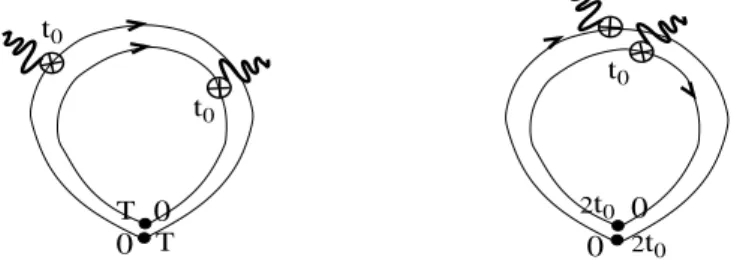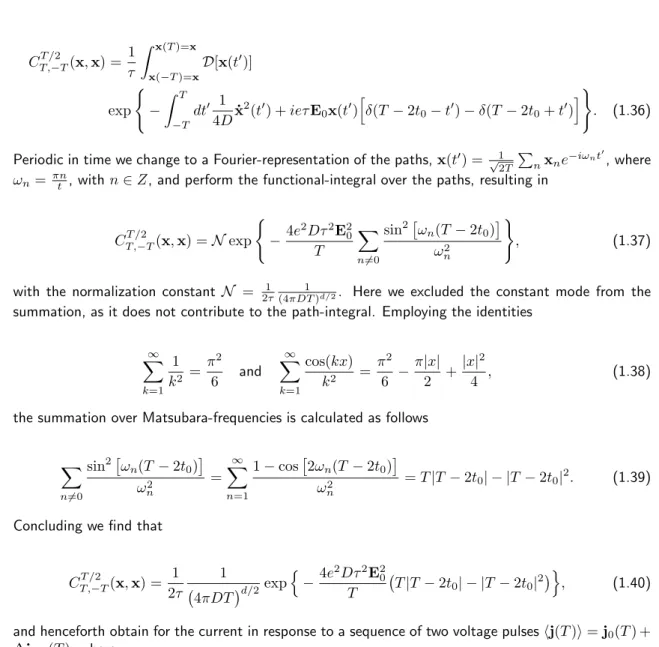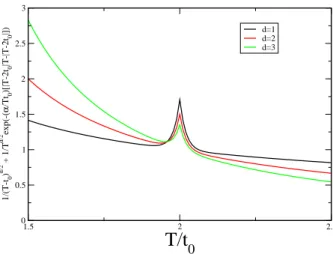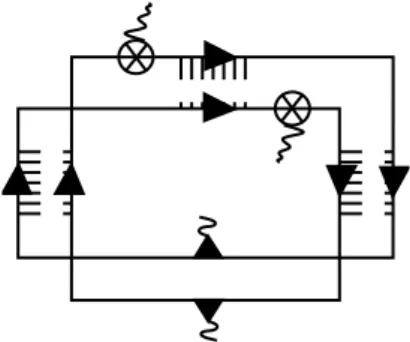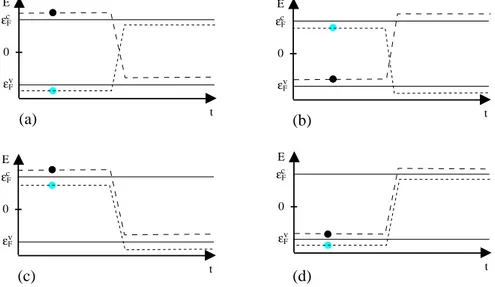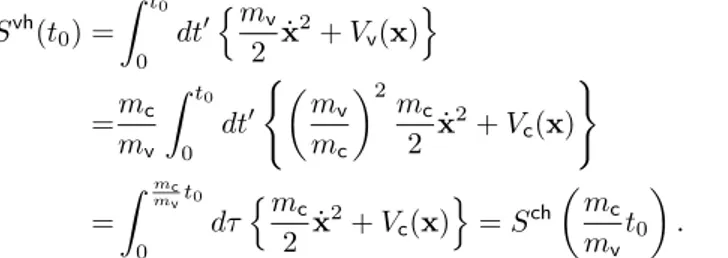Application of field theoretical methods to problems in mesoscopic physics
Inaugural-Dissertation zur
Erlangung des Doktorgrades
der Mathematisch-Naturwissenschaftlichen Fakult¨at der Universit¨at zu K¨oln
vorgelegt von Tobias Micklitz
aus M¨unchen 2006
Prof. Dr. A. Rosch
Tag der letzten m¨undlichen Pr¨ufung: 09.02 - 28.02.07
Abstract
The subject of this thesis are three different topics related to quantum interference and dephasing in weakly disordered mesoscopic systems.
The first topic covers the so-called “current echo”, which is a quantum-interference phenomenon predicted about a decade ago by Thomaset al. on the basis of numerical calculations. Our motivation to study the current echo originates from the fact that a simple physical picture explaining its appearance so far has been missing. It is shown that all characteristic features of Thomas’ current echo can be explained resorting to the well known phenomenon of weak localization in disordered systems. In view of recent technological progress in the creation of voltage pulses on a pico-second time scale, the experimental verification of the current echo should be feasible. The echo phenomenon may become a useful tool to determine dephasing rates in weakly disordered systems.
The second topic is titled “Dephasing by Kondo impurities”. In this part of the thesis we derive an analytical expression for the dephasing rate of non-interacting electrons propagating in a weakly disordered environment and scattering from very low concentrations of magnetic impurities. The mo- tivation to study dephasing due to Kondo impurities traces back to a series of experiments performed over the last decade which show an unexpected saturation of the dephasing rate at lowest temperat- ures. The observed saturation clearly deviates from theoretical predictions based on the assumption that inelastic scattering due to electron-electron interactions is the dominant mechanism for dephasing.
Therefore, it was suggested, that inelastic scattering from low concentrations of magnetic impurit- ies may be responsible for the observed excess of dephasing. So far these speculations could not be quantitatively tested, since the dephasing rate due to diluted magnetic impurities in the experimentally probed range of temperature was unknown. Based on our results a quantitative comparison between theoretically predicted and experimentally measured dephasing rate was done. This allowed for a critical examination of the relevance of low concentrations of magnetic impurities for the observed behaviour of the dephasing rate. Moreover, this part of the thesis analyzes the magnetic field dependence of the dephasing rate due to magnetic impurities and generalizes the results for the dephasing rate from magnetic to arbitrary diluted dynamical impurities.
The third topic of this thesis relates to quantum interference and dephasing in a disordered Lut- tinger liquid. The standard approach to describe interacting one-dimensional systems is the bosoniza- tion method, which, however, becomes very intransparent when in addition disorder comes into play.
Therefore, quantum interference phenomena and dephasing in a disordered Luttinger liquid remained unaddressed for a long time. In this part of the thesis we follow a new road and derive an effective field theory for the disordered Luttinger liquid. This model allows to systematically explore interference phenomena in disordered Luttinger liquids. As an application of the model we discuss for the first time the persistent current in a weakly disordered Luttinger liquid.
3
Zusammenfassung
Die vorliegende Arbeit besch¨aftigt sich mit drei verschiedenen Themengebieten, in deren Mittelpunkt quantenmechanische Interferenzph¨anomene und der Verlust von Phasenkoh¨arenz (Dephasierung) in schwach ungeordneten mesoskopischen Systemen stehen.
Im ersten Abschnitt der Arbeit diskutieren wir sogenannte “Stromechos”, ein quantenmechanisches Interferenzph¨anomen, welches vor einem Jahrzehnt von Thomas et al. aufgrund numerischer Rech- nungen vorhergesagt wurde. Die Motivation, uns mit den Stromechos zu besch¨aftigen, resultiert aus der Tatsache, dass eine einfache physikalische Erkl¨arung dieses Ph¨anomens fehlte. In der Tat kann gezeigt werden, dass alle in den numerischen Rechnungen gefundenen Eigenschaften des Echos mit derselben Physik erkl¨art werden k¨onnen, welche der schwachen Lokalisierung in ungeordneten Systemen zugrundeliegt. Angesichts des rasanten technischen Fortschrittes in der Erzeugung von Spannungspulsen auf Zeitskalen von Pikosekunden, scheint eine experimentelle Verifizierung des Stromechos realisierbar.
Praktische Bedeutung k¨onnen die Stromechos in der Bestimmung von Dephasierungsraten erhalten.
Im zweiten Abschnitt, dem Themengebiet “Depahsing due to Kondo impurities”, berechnen wir die Dephasierungsrate von Elektronen, die durch ein ungeordnetes System propagieren und an einer geringen Konzentration magnetischer Unreinheiten streuen. Unser Interesse an diesem Problem geht auf zahlreiche Experimente zur¨uck, welche im Laufe des letzten Jahrzehnts durchgef¨uhrt wurden und eine unerwartete S¨attigung der Dephasierungsrate bei tiefsten Temperaturen zeigen. Die beobachtete S¨attigung weicht von theoretischen Vorhersagen ab, welche auf der Annahme basieren, dass die Depha- sierung allein durch Elektron-Elektron-Wechselwirkung verursacht wird. Daher wurde vermutet, dass inelastische Streuung an stark verd¨unnten magnetischen Verunreinigungen den wesentliche Beitrag zur Dephasierung bei tiefen Temperaturen liefert. Diese Vermutung konnte jedoch bisher nicht quantita- tiv ¨uberpr¨uft werden, da die Dephasierungsrate, welche von inelastischer Streuung an magnetischen Verunreinigungen herr¨uhrt, in dem experimentell untersuchten Temperaturbereich nicht bekannt war.
Basierend auf unserem Ergebnis konnte nun erstmals die Vermutung, dass geringe Konzentrationen von magnetische Unreinheiten verantwortlich f¨ur die experimentell beobachtete S¨attigung der Dephasier- ungsrate bei tiefen Temperaturen sind, kritisch ¨uberpr¨uft werden. Weiterhin diskutieren wir in diesem Abschnitt der Arbeit die Magnetfeldabh¨angigkeit der Dephasierungsrate, und verallgemeinern unsere Ergebnisse von magnetischen auf beliebige, verd¨unnte dynamische Verunreinigungen.
Im dritten Abschnitt der Arbeit diskutieren wir quantenmechanische Interferenz und Dephasier- ung in Luttinger-Fl¨ussigkeiten. Eine sehr effiziente Methode zur Beschreibung wechselwirkender, ein- dimensionaler Systeme ist das Bosonisierungs-Verfahren. Kommt jedoch zus¨atzlich Unordnung ins Spiel, wird diese Methode sehr undurchsichtig. Deshalb wurden quantenmechanische Interferenz und Dephasierung in ungeordnetenLuttinger-Fl¨ussigkeiten f¨ur lange Zeit nicht untersucht. In diesem Ab- schnitt der Arbeit leiten wir eine effektive Feldtheorie f¨ur ungeordnete Luttinger-Fl¨ussigkeiten ab, welche eine systematische Untersuchung quantenmechanischer Interferenzphenom¨ane erlaubt. Als Anwendung unseres Models diskutieren wir erstmals Dauerstr¨ome in einer ungeordneten Luttinger Fl¨ussigkeit.
5
Contents
1 Current-Echoes in Metals and Semiconductors 11
1.1 Keldyshσ-model for systems with time-reversal invariance . . . . 12
1.2 Current in linear response to a pulsed electrical field . . . . 16
1.3 Cooperon in a pulsed electric field . . . . 17
1.4 Semiclassical analysis of the current-echo . . . . 20
1.5 Current-echo in semiconductors . . . . 22
1.6 Summary and outlook . . . . 26
2 Dephasing by Kondo Impurities 29 2.1 Replica NLσM for disordered electron gas containing diluted magnetic impurities . . . . 30
2.2 Dephasing by static magnetic impurities . . . . 35
2.3 Dephasing due to dynamical magnetic impurities . . . . 37
2.3.1 Introduction of elastic and inelastic vertices . . . . 37
2.4 Dephasing-rate measured from the magnetoresistance . . . . 39
2.4.1 The dephasing rate measured in WL experiments . . . . 39
2.4.2 1. Contributions from inelastic vertex . . . . 41
2.4.3 2. Contributions from mixed diagrams . . . . 45
2.4.4 3. Contributions from higher-order corrections innS . . . . 46
2.4.5 Interplay: Kondo effect and electron-electron interactions . . . . 46
2.5 Summary . . . . 46
2.6 Generalizations . . . . 47
2.7 Dephasing-rate measured from universal conductance fluctuations and Aharonov-Bohm oscillations . . . . 49
2.8 Dephasing-rate measured from the current echo . . . . 54
2.9 Comparison to recent experiments and outlook . . . . 54
3 Disordered Luttinger Liquid 59 3.1 The model . . . . 60
3.2 Bosonization of non-interacting electrons in a clean wire: three equivalent approaches . 61 3.2.1 Standard bosonization . . . . 61
3.2.2 Functional bosonization . . . . 62
3.2.3 σ-Model bosonization . . . . 63
3.2.4 Higher loop corrections to the Gaussian propagator . . . . 71
3.2.5 Summary of this section and outlook . . . . 72
3.3 Interacting electrons in a clean wire: Equivalence of the three approaches . . . . 72
3.3.1 Standard bosonization . . . . 72
3.3.2 Functional bosonization . . . . 73
3.3.3 σ-model bosonization . . . . 74
3.3.4 Summary of this section . . . . 74
3.4 Inelastic scattering rate in a clean Luttinger liquid . . . . 75
3.4.1 Screening the Coulomb-interactions . . . . 76
3.4.2 The inelastic scattering rate . . . . 76
3.4.3 Summary of this section . . . . 78 7
3.5 Electrons in a disordered one-dimensional system . . . . 78
3.5.1 Localization in a disordered 1d system . . . . 79
3.5.2 Drude conductivity and weak localization in a disordered 1d system . . . . 80
3.5.3 Summary of this section . . . . 81
3.6 Interacting electrons in a disordered 1d system . . . . 82
3.6.1 RPA screening in a disordered system . . . . 83
3.6.2 “Renormalization” of disorder by electron-electron interactions . . . . 84
3.6.3 Summary of this section and outlook . . . . 86
3.7 An Application: Persistent current in a Luttinger liquid . . . . 86
3.7.1 Persistent current in a clean Luttinger liquid . . . . 86
3.7.2 Persistent current in a weakly disordered Luttinger liquid . . . . 90
3.7.3 Summary of this section . . . . 98
3.8 Summary and outlook . . . . 98
A Appendix (Dephasing by Kondo impurities) 101 A.1 Gradient expansion . . . . 101
A.2 Spin-singlet and spin-triplet channels . . . . 103
A.2.1 Spin-singlet channels . . . . 103
A.2.2 Spin-triplet channels . . . . 104
A.3 Response kernels in Gaussian approximation . . . . 106
A.3.1 Response kernel for weak localization experiment . . . . 106
A.3.2 Response kernel for Aharonov-Bohm oscillations . . . . 107
A.4 Some details . . . . 109
A.5 Some more details . . . . 110
A.6 Renormalized perturbation theory for the Anderson model . . . . 110
A.7 Fluctuations of the Kondo-temperature . . . . 111
A.8 Limits of applicability: Cross-over temperatures for the dephasing-rate . . . . 112
A.8.1 Evaluation of the diagrams . . . . 114
A.9 Analytical continuation . . . . 114
A.9.1 Self-energy corrections∆σ1 . . . . 114
A.9.2 Vertex corrections∆σ2 . . . . 116
A.10 Lehmann representation . . . . 117
A.10.1 Self-energy . . . . 117
A.10.2 Two-vertex . . . . 117
A.10.3 Three-vertex . . . . 118
A.10.4 Four-vertex . . . . 119
B Appendix (Disordered Luttinger Liquid) 127 B.1 l0-independent contributions from the“ tr ln ”-expansion . . . . 127
B.2 Diagrammatic evaluation of the density/density correlation function . . . . 130
B.3 Regularization of the propagator . . . . 131
B.4 Equivalence of Eq.(3.68) and Eq.(3.72) . . . . 132
B.5 Equivalence of Eq.(3.72) and Eq.(3.74) . . . . 133
B.6 Dephasing rates . . . . 134
B.7 Inclusion of back-scattering disorder . . . . 135
B.8 Some details . . . . 136
B.8.1 Analytical continuation ofSχ[CfbCbf] . . . . 136
B.8.2 Poisson summation . . . . 137
B.8.3 Performing they-integral . . . . 137
B.8.4 Coulomb field propagator . . . . 138
Introduction
The quantum mechanical wave-nature of matter not only appears on microscopic scales, but also can be studied in systems with macroscopic numbers of degree of freedom, as e.g. mesoscopic metals and semiconductors at low temperatures. The electron’s wave nature manifests itself in its ability to interfere. Interference effects play an important role in disordered systems: Electrons scatter from impurities and form a complicated interference pattern, giving rise, on the one hand, to measurable deviations from classically expected values of observables, such as the conductivity, and, on the other hand, leading to new, classically not expected phenomena.
A new “interference-phenomenon”, the so-called current echo, has been predicted by Thomas et al. about a decade ago. The predictions are based on numerical calculations and a simple physical interpretation for the current echo has been missing so far. In the first chapter of this thesis we will discuss this phenomenon and suggest an explanation which resorts only to the well-established theory of weak localization in disordered metals of non-interacting electrons.
In real physical systems the particle are, however, always exposed to interactions, which can be intrinsic (such as electron-electron interactions) or extrinsic due to interactions with an environment (such as dynamical impurities). Inelastic interaction processes lead to the destruction of the electron’
s phase coherence and therefore suppress interference phenomena. Phase space arguments lead to the expectation that dephasing of electrons in a Fermi sea becomes ineffective when the temperature is lowered. At lowest temperatures the electrons phase coherence should be fully re-established. Ir- ritatingly, however, several experiments performed over the last decade, indicate a saturation of the dephasing rate at lowest temperatures. It was suggested that this excess of dephasing results from scattering of electrons at extremely low concentrations of magnetic impurities, which are inevitably contained in the probes. In the second chapter of this thesis we will tackle this problem with the aim to derive an analytical expression for the dephasing rate of electrons interacting with low concentrations of magnetic impurities.
Interactions not only cause dephasing but may also drastically change the systems properties. Arbit- rary weak electron-electron interactions in one-dimensional systems are known to turn the system into a non-Fermi liquid state, the so-called Luttinger liquid. The Luttinger liquid is e.g. characterized by power-laws for the temperature and bias-voltage dependence of the tunneling current, which has been experimentally verified e.g. in carbon nanotubes. The standard approach to interacting one-dimensional systems is the bosonization method. This method, however, becomes very intransparent when disorder comes into play. Therefore, quantum interference phenomena and dephasing in a Luttinger liquid re- mained unaddresses for a long time. In the third chapter of this thesis we use a different approach to analyze disordered interacting one-dimensional systems. This approach leads to a field theory which is the single-channel limit of an “universal” model for disordered interacting systems, known from higher dimensions and which allows for a transparent description of interference phenomena. A practical ap- plication of this model will be the analysis of the persistent current in a disordered single-channel ring of (weakly) interacting electrons.
As indicated in the title we employ field theoretical methods to address the above mentioned prob- lems. More precisely we use the nonlinearσ-model and the closely related diagrammatic perturbation theory in terms of Greens functions.
9
Chapter 1
Current-Echoes in Metals and Semiconductors
Introduction: Based on numerical calculations within the Anderson impurity model of non-interacting electrons Thomas et al. suggested about a decade ago the existence of current-echoes in disordered metals [1]. Experimentally, the generation of such current-echos is highly non-trivial, as it requires voltage pulses on time scales shorter than the dephasing time, which is typically of the order or less than nano seconds. Indeed, an experimental verification of their existence is so far lacking. Therefore, having in mind the feasibility to optically generate ultra-short current pulses in semiconductors on a femto- to picosecond time scale (by use of coherent control techniques, see e.g. [2, 3, 4]) numerical analysis of the echo scenario was extended to semiconductors [5, 6]. However, we do not know of any experiments probing the echo in semiconductors. Also, in later works the influence of electron-electron interactions on the echo has been studied [7]. The features characterizing the echo phenomenon in metals and semiconductors as found by numerical studies can be summarized as follows (the interested reader can find more details in [1, 5, 6]):
1. Current-echo in metals: A disordered conductor exposed to a short voltage pulse at time t= 0 generates a current pulse, which decays within the elastic scattering time. For a system without Coulomb interaction and in the absence of other dephasing mechanism, a second voltage pulse at t = t0 leads to the reconstruction of a macroscopic current burst at t = 2t0, opposite in sign to the original current pulses. Inclusion of Coulomb interactions (exponentially) reduces the amplitude of the echo.
2. Current-echo in semiconductors: In a two-band semiconductor with correlated disorder (for a definition of correlated disorder see section 1.5 “Current-Echo in Semiconductors” below) and different masses of the charge carriers in conduction and valence band the application of coherent control schemes at time t = 0 optically generates short inter- and intraband current pulses decaying due to elastic scattering from disorder. A second pulse applied at time t =t0 again leads to the appearance of a current-echo. Three main findings characterize the current-echo in semiconductors:
(a) The echo only appears in the model with correlated disorder.
(b) In the case of correlated disorder, the echo even shows up for a simplified excitation sequence, where only the first light-pulse creates inter- and intraband current pulses whereas the second pulse is a simple full-gap pulse causing inversion of the band charges. That is, only one current pulse — which has to be the first pulse — is necessary to generate the echo.
Reversing the order of pulses does not obtain an echo.
(c) Most surprisingly, for different masses,mc< mv, of the charge carriers in the conduction and valence band, respectively, the intraband current-echo splits into two separate contributions:
a conduction band response at the advanced timetc=
1 +mmcv
t0and a delayed response in the valence band at the retarded time tv =
1 +mmvc
t0. The interband echo, on the other hand, always appears att= 2t0
11
Interestingly to us, a simple picture explaining the physics behind the current echo so far has been missing. Therefore we found it challenging to look for a microscopic mechanism explaining the diversity of features characterizing the current-echo in metals and semiconductors. An explanation based on the constructive interference of time-reversed paths is given in the following sections.
Outline: The outline of the rest of the chapter is the following: In order to make this text self- contained we derive in the first section the basic equations (two particle- or “Cooperon”-equation) lying at the heart of our explanation of the current-echo. These equations can be found in textbooks (e.g.
[16]) but we here use a different derivation within the Keldysh σ-model. Rather technical in nature, this section can be skipped as it does not give any new results.
In the second section we repeat [9] that in response to a pulsed electric field, the weak localiza- tion corrections to the conductivity (which can be described in terms of the two particle propagator
“Cooperon”) give rise to a negative current, decaying algebraically in time (if perfect phase coherence is assumed). This observation leads us to study in the third section the fate of the Cooperon in the pres- ence of an external electric field, or, more specifically, when a second voltage pulse is applied. Indeed, we show that due to breaking of time-reversal symmetry by the second pulse, the Cooperon becomes suppressed — except for a short momentT = 2t0when time reversal symmetry is re-established. In this way we can understand the current-echo as a sudden re-appearance of the weak localization contribution to the current. In the fourth section we re-derive the results of the third section from a semiclassical approach, and, finally, in the fifth section employ the semiclassical approach to explain the current-echo in semiconductors.
1.1 Keldysh σ-model for systems with time-reversal invariance
Consider ad-dimensional weakly disordered metal described by the Lagrangian
L[ ¯ψψ, φ,A] = Z
ddxψ(x, t)¯
i∂t+eφ(x, t) +µ+ 1
2m[∂−ieA(x, t)]2−Udis(x)
ψ(x, t), (1.1) where ψ,¯ ψ are the electron and hole fields, Udis is a white noise disorder potential, described by its second moment,
hUdis(x)Udis(x′)idis= 1
2πντδ(x−x′), (1.2)
andφandAdenote some scalar and vector potentials. Within the Keldysh approach the time evolution of the system is considered along the Keldysh contourCgoing fromt=−∞tot= +∞and then back to−∞(see Fig. 1.1). At the initial time,t=−∞, the system is supposed to be in thermal equilibrium, with all external fields and the disorder potential turned off. The partition function describes the evolution along the contourC and can be written in terms of the functional integral over the fermionic fieldsψ,¯ ψ as a function of the external fieldsφandA,
Z[φ,A] = Z
D[ ¯ψ, ψ]hexp
iS[ ¯ψψ, φ,A] idis, (1.3) with the action given byS[ ¯ψψ, φ,A] =R
CdtL. If all external fields are classical — that is identical on the forward and backward branch of the time contour — then the Keldysh contour brings the system back to the initial state. In this case the partition function is automatically normalized to unity, i.e.
Z = 1. To get non-trivial results one has to introduce external fields with quantum components.
Expectation values of operators are then given by functional derivatives of the free energy with respect to the quantum component of the field coupling to the operator.
Following the strategy outlined in [10] we resemble the fields living on the forward and backward component of the time contour in a single vector (matrix)
1.1. KELDYSH σ-MODEL FOR SYSTEMS WITH TIME-REVERSAL INVARIANCE 13
C
−∞ ∞ t
Figure 1.1: Schematic representation of the time contourC used in Keldysh formalism.
ψ¯= ¯ψ1 ψ¯2
K, ψ= ψ1
ψ2
K
, φ= φ1
φ2
K
, A= A1
A2
K
. (1.4)
Here 1, 2 labels the Keldysh components for the fields residing on the forward/backward branch of the time contour. In this new fields the action readsS=R∞
−∞dtL, where
L= Z
ddxψ¯n
i∂t+eφ+µ+ 1
2m[∂−ieA]2−Udis
o
σ3Kψ. (1.5)
Employing that the partition function is normalized for vanishing external quantum fields (notice that Udisis a classical field), expectation values of operators can as well be written as functional derivatives of the partition function Z itself instead of the free energy lnZ. The average of Z over disorder configurations is readily done. It generates a four-fermion term local in space but non-local in time,
Sint[ ¯ψψ] = i 4πντ
Z ∞
−∞
dt Z ∞
−∞
dt′ Z
ddxψ(x, t)σ¯ 3Kψ(x, t) ¯ψ(x, t′)σK3ψ(x, t′), (1.6) reflecting the fact that the impurity scattering considered here is elastic. Separation into slow momenta
|q| ≪pF and fast momenta |p|,|p′| ∼pF we neglect the contribution from the density channel as it only constitutes renormalization of the chemical potential,µ, and, thus, only retain the Cooper and the exchange channels,
Sint[ ¯ψψ]≈ i 4πντ
Z ∞
−∞
dt Z ∞
−∞
dt′ X
q≪p,p′∼pF
ψ¯p+q(t)σK3ψp′(t) ¯ψp′+q(t′)σK3ψp(t′) + ¯ψp+q(t)σ3Kψp′+q(t) ¯ψ−p(t′)σK3ψ−p′(t′) . (1.7) As pointed out e.g. in [11] among the four Keldysh sub-blocks of the Green’s function only three are linearly independent. To make use of this property it is convenient to pass to a rotated basis in Keldysh space, where
Gˆt,x−1=n
i∂t+φiγi+µ+ 1 2m
∂−ieAiγi2o
. (1.8)
Hereφiγi=φclγcl+φqγq(as common we useγ1= 1Kandγ2=σ1K) and correspondingly forA. Notice though that Eq. (1.8) is a somewhat symbolical form as a more careful representation takes care of the fact thatGhas off-diagonal structure inK-space, even in the case of vanishing external (quantum) fieldsφq. This results from the fact, that the forward and backward segments of the time-contour are connected at t=∞. (For a discussion of this point see e.g. [12]). In this new basis, the quartic part of the action reads
Sint[ ¯ψψ] = i 4πντ
Z ∞
−∞
dt Z ∞
−∞
dt′ X
q≪p,p′∼pF
nψ¯p+q′ (t)ψp′′(t) ¯ψp′′+q(t′)ψp′(t′) + ¯ψp+q′ (t)ψ′p′+q(t) ¯ψ−′p(t′)ψ′−p′(t′)o
. (1.9)
In order to decouple in the two relevant channels (Cooper and exchange) simultaneously we introduce the two component spinors
Ψ(q, t) = √12
ψ(q, t) ψ¯τ(q,−t)
T
, Ψ(q, t) =¯ √12 ψ(¯ q, t) −ψt(q,−t)
T. (1.10)
Here τ refers to the transpose in K-space and T stands for time-reversal space. That is, we enlarge the internal field space from Kto K⊗T. With these definitions we rewrite the quadratic part of the action as
S = Z
dt Z
ddxΨ(t,¯ x) Gˆt,x−1
Gˆt,x−1
t
!
T
Ψ(t,x). (1.11)
The doubling of field space allows for summarizing the slow part of the four-fermion term in the form
Sint = i 2πντ
Z
dtdt′ X
q≪p,p′
Ψ¯p+q(t)Ψp′(t) ¯Ψp′+q(t′)Ψp(t′). (1.12)
Notice that the presence of a Keldysh component in the propagatorG explicitly breaks time-reversal invariance. Furthermore external fields become matrices inT-space of the form
Ai(t) = Ai(t)
−Ai(−t)
T
and φi(t) = φi(t)
φi(−t)
T
. (1.13)
Here the “−”sign in the second component of the vector potential emerges due to partial integration.
Finally, we mention that due to the field-doubling the electron-fields Ψ¯ and Ψ are not independent variables anymore, but related by the symmetry-transformation
Ψ¯q(t) =−Ψτq(−t)iσ2T. (1.14) We now follow the usual lines [10] to formulate an effective field-theory grasping the relevant physics.
These steps consist in (a) introduction of new degrees of freedom (Hubbard-Stratonovich (HS) trans- formation), (b) integration over fermion fields, (c) mean-field approximation for HS-field, (d) gradient expansion around mean-field, and lead to the effective action
iSσ[Q] =−πν 4
Z dtdt′
Z
ddxtrK⊗T
n4∂tQ−4iφiγiQ−D ∂Q−e
Aiγi, Q2o
, (1.15) where the HS-field Qtt′(x) is a matrix in space-time as well as in the product-space K⊗T-space; it is local in the coordinate-space (which is a hallmark of the δ-correlated disorder-potential considered here) and non-local in time. The symmetry relation of the electron-fields, Eq.(2.12), translates to the property
Qτtt′(q) =σT2Q−t′,−t(q)σ2T, (1.16) whereτrefers to transposition inK⊗T-space. Qdescribes fluctuations around the saddle pointΛ, i.e.
Q= ΛeW, where
Λ = λt−t′
λτt−t′
T
, and λt−t′ =
δt−t′−0 2Ft−t′
−δt−t′+0
K
. (1.17)
Ft−t′ =−iT /sinh[πT(t−t′)]is the Fourier-transformed Fermi-distribution function and for a definition ofδt±0 see e.g. [10]. Notice that the above representation ofQrequires that the rotations generated
1.1. KELDYSH σ-MODEL FOR SYSTEMS WITH TIME-REVERSAL INVARIANCE 15
byW act on the saddle point fixed-point free, i.e.
Λ, W
= 0. Notice also thatΛfulfills the symmetry constraint Eq. (2.18). At this point it is convenient to introduce the self-inverse matrix (i.e. F2= 1)
Ft−t′ ≡ ft−t′
ftt−t′
T
, where ft−t′≡
δt−t′−0 Ft−t′
−δt−t′+0
K
, (1.18)
which allows the decompositions Λ = FσK3F and W ≡ FWF. Employing that Λ, W
= 0 is equivalent to
σ3K,W
= 0, we parametrize the generators of the rotations by
WC=
C¯ C
K
and WD=
D¯ D
K
, (1.19)
where we separated into a part diagonal in T-space (Diffuson) and a part off-diagonal in T-space (Cooperon), i.e.
C¯=
C¯+− C¯−+
T
C=
C+− C−+
T
D¯ = D¯++
D¯−−
T
D= D++
D−−
T
. (1.20) From an expansion to second order in the generators we get
iS2σ[ ¯CC] =−πν 2
Z dtdt′
Z
ddxtrT
n(∂t+ieφ(x, t))C¯tt′(x)Ct′t(x)
−Ctt′(x) ¯Ct′t(x)
+D∂2C¯tt′(x)Ct′t(x)o
, (1.21)
and correspondingly for the Diffuson. For convenience we only took into account a classical electrical potentialφ, and dropped out the vector potentialA. We later reinstall the vector potential by gauge arguments. Next, we perform the trace overT-space and use that the symmetry relation for the matrix components are given byCtt−′+ =−C¯−−t+−t′ andCtt+′− =−C¯−+t−−t′ for the off-diagonal components and Dtt++′ = ¯D−−−t−t′ andD−−tt′ = ¯D++−t−t′ for the diagonal ones and get
iSσ2[ ¯CC] =−πν 2
Z dtdt′
Z
ddxtrT
n ∂t−∂t′+ie[φ(x, t)−φ(x, t′)] +D∂2C¯t,+−−t′(x)C−−t+′,t(x)o (1.22) for the Cooperon and
iSσ2[ ¯DD] =−πν 2
Z dtdt′
Z
ddxtrT
∂t+∂t′+ie[φ(x, t)−φ(x, t′)] +D∂2D¯++tt′ (x)Dt−−′t (x) (1.23) for the Diffuson. That is thehC¯+−C−+iandhD¯++D++icorrelations solve the differential equations
n
∂t+
1 −∂t−
1 −D∂2−ie
φ(t+1)−φ(t−1)o hC¯t++−
1t−1(x)Ct−−+
2t+2(x′)i= 2
πνδ(x−x′)δ(t+1 −t+2)δ(t−1 −t−2) (1.24) n∂t+
1 +∂t−
1 −D∂2−ie
φ(t+1)−φ(t−1)o hD¯t+++
1t−1(x)Dt++−
2t+2(x′)i= 2
πνδ(x−x′)δ(t+1 −t+2)δ(t−1 −t−2).
(1.25) Finally, we introduce the center-of-mass and relative times, T1/2 ≡ t
+ 1/2+t−1/2
2 and η1/2 ≡ t+1/2−t−1/2 and define the Diffuson and Cooperon respectively as
hC¯+−
t+1,−t−1(x)C−+
−t+2,t−2(x′)i ≡ 2τ
πνCηT11η2(x,x′)δ(T1−T2) (1.26) hD¯++
t+1t−1(x)D++
t+2t−2(x′)i ≡ 2τ
πνDTη11T2(x,x′)δ(η1−η2). (1.27) This leads us to the well-known differential equations for the Cooperon and Diffuson,
2∂η1−D
∂+ieh
A(T1+η1
2) +A(T1−η1
2)i2
−ieh φ
T+η1
2
−φ T −η1
2 i
CηT1η2(xx′)
= 2
τδ(η1−η2)δ(x−x′) (1.28)
∂T1−D
∂+ieh
A(T1+η1
2 )−A(T1−η1
2 )i2
−ieh φ
T1+η1
2
−φ T1−η1
2
iDηT11T2(x,x′)
= 1
τδ(T1−T2)δ(x−x′) (1.29) Here we re-introduced the (classical) vector potentialAby demanding invariance of the equations under the gauge transformation A7→A+∂χ,φ7→φ+∂ηχ(φ7→φ+∂Tχ) and
CηηT′(x,x′)7→e−ie[χ(x,T+η/2)+χ(x,T−η/2)]CηηT′(x,x′)eie[χ(x′,T+η′/2)+χ(x′,T−η′/2)] DηT T′(x,x′)7→e−ie[χ(x,T+η/2)−χ(x,T−η/2)]DηT T′(x,x′)eie[χ(x′,T′+η/2)−χ(x′,T′−η/2)].
The differential equation for the Cooperon, Eq. (1.28), are the starting point for our analysis of the echo scenario.
Τ+η/2 Τ−η/2
Τ+η/2 Τ−η/2
R A
Τ+η/2
Τ−η/2 Τ−η/2 A
R
x x’ x x’
Τ+η/2
Figure 1.2: Cooperon (left) and Diffuson (right) in real-time representation. Dashed lines represent disorder scattering and R/Astands for retarded and advanced Green functions (i.e. for electron and hole lines). Notice that the propagation of the electron is denoted by an arrow, whereas the hole passes the line in opposite direction the arrow points to.
1.2 Current in linear response to a pulsed electrical field
Let us now turn to the response of a metal exposed to a voltage pulse. The electric current is calculated from the functional derivative of the free energy — or equivalently the partition function — with respect to the quantum component of the vector potential. Therefore the current in linear response to a homogeneous (classical) external field,Ecl=−∂tAcl, is given by
hj(t)i= Z
dt′ δ2Z
δAq(t)δAcl(t′)Acl(t′).
Having done the two-fold derivative of the partition function Eq. (2.22) we expand the resulting ex- pression in fluctuation matrices W around the saddle point valueΛ. Each powerW2k corresponds to quantum corrections of the order(kFl)−k to the classical value of the current, obtained from inserting


